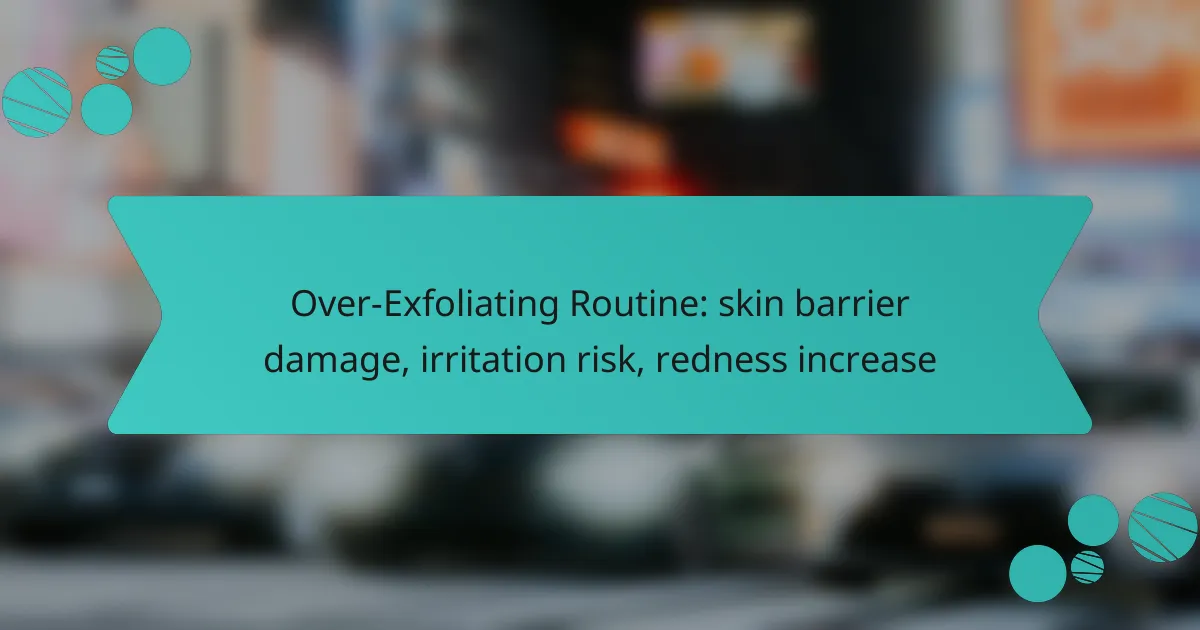Over-exfoliating can lead to significant skin issues, including barrier damage, irritation, and increased redness. Recognizing the symptoms of over-exfoliation is crucial for maintaining healthy skin, as excessive exfoliation can compromise its overall health. By understanding the best practices for exfoliation, you can effectively remove dead skin cells while protecting your skin’s integrity.

How to identify over-exfoliating symptoms?
To identify over-exfoliating symptoms, look for signs of skin barrier damage, irritation, and increased redness. These symptoms indicate that your skin may be reacting negatively to excessive exfoliation, which can compromise its health.
Skin barrier damage signs
Common signs of skin barrier damage include dryness, flakiness, and a tight feeling on the skin. You may also notice an increase in sensitivity to products that previously did not irritate your skin.
If your skin is showing signs of cracking or peeling, it may be a clear indication that the barrier is compromised. In such cases, reducing exfoliation frequency is crucial to allow the skin to recover.
Common irritation symptoms
Irritation from over-exfoliating often manifests as stinging, burning, or a prickly sensation on the skin. These symptoms can occur immediately after exfoliation or may develop over time with continued use.
Additionally, you might experience a heightened reaction to skincare products, resulting in discomfort or an allergic-like response. If irritation persists, consider switching to gentler exfoliation methods.
Indicators of increased redness
Increased redness is a prominent indicator of over-exfoliation. If your skin appears flushed or has a persistent rosy hue, it may be reacting to excessive exfoliation.
Look for patterns such as redness that lasts longer than a few hours or occurs frequently after exfoliating. This can signal that your skin is struggling to cope with the level of exfoliation being applied.

What are the best practices for exfoliation?
To maintain healthy skin, it’s essential to follow best practices for exfoliation, which include frequency, method, and product choice. Proper exfoliation helps remove dead skin cells without damaging the skin barrier or causing irritation.
Recommended exfoliation frequency
Exfoliation frequency largely depends on your skin type. For most skin types, exfoliating 1-3 times a week is sufficient to promote cell turnover without risking irritation. Sensitive skin may benefit from less frequent exfoliation, perhaps once every 10-14 days.
Pay attention to how your skin reacts; if you notice increased redness or irritation, reduce the frequency. It’s also wise to adjust based on seasonal changes, as skin may become more sensitive in colder months.
Gentle exfoliation methods
Opt for gentle exfoliation methods to minimize the risk of damaging your skin barrier. Chemical exfoliants, such as AHAs (alpha hydroxy acids) and BHAs (beta hydroxy acids), can be effective yet less abrasive than physical scrubs. Look for products with lower concentrations to start.
When using physical exfoliants, choose ones with fine particles and avoid harsh scrubs. Always apply with light pressure and avoid areas with active breakouts or irritation.
Products for sensitive skin
For sensitive skin, select products specifically formulated to be gentle and soothing. Look for exfoliants that contain calming ingredients like aloe vera, chamomile, or green tea. Brands often label their products as “sensitive skin-friendly” or “non-irritating.”
Consider starting with a patch test to ensure compatibility. Products with lower concentrations of exfoliating acids, such as 5-10% AHAs or 1-2% BHAs, are typically safer choices for sensitive skin types.

How to repair skin barrier after over-exfoliation?
To repair your skin barrier after over-exfoliation, focus on hydration, soothing ingredients, and sun protection. These steps help restore the skin’s natural barrier function and reduce irritation.
Moisturizing techniques
Effective moisturizing techniques include using emollients and occlusives to lock in moisture. Look for products that contain ingredients like glycerin, hyaluronic acid, or ceramides, which can help replenish lost hydration.
Apply moisturizer immediately after cleansing to trap moisture in the skin. Consider using a thicker cream or ointment at night for added hydration while you sleep.
Recommended healing ingredients
Incorporate healing ingredients such as panthenol, niacinamide, and aloe vera into your skincare routine. These components are known for their soothing properties and can help reduce redness and irritation.
Additionally, avoid active ingredients like retinoids and acids until your skin barrier is fully repaired, as they can exacerbate sensitivity.
Importance of sun protection
Sun protection is crucial when repairing an over-exfoliated skin barrier. UV exposure can further damage sensitive skin and hinder the healing process. Use a broad-spectrum sunscreen with an SPF of at least 30 daily.
Reapply sunscreen every two hours, especially if you are outdoors. Wearing protective clothing and seeking shade can also help minimize sun exposure during the healing phase.

What are the risks of over-exfoliating in the UK?
Over-exfoliating can lead to significant skin issues, including barrier damage, irritation, and increased redness. In the UK, where climate and environmental factors can affect skin health, it’s crucial to understand these risks to maintain a balanced skincare routine.
Long-term skin damage
Excessive exfoliation can compromise the skin’s natural barrier, leading to long-term damage. This may manifest as dryness, flakiness, or even permanent changes in skin texture. Individuals may notice increased fine lines and a dull complexion as the skin struggles to recover.
To prevent long-term damage, limit exfoliation to once or twice a week, depending on your skin type. Choose gentle exfoliants and monitor your skin’s response to avoid overdoing it.
Increased sensitivity to products
Over-exfoliating can heighten skin sensitivity, making it more reactive to skincare products and environmental factors. This increased sensitivity may result in stinging, burning, or redness when applying even mild products.
To manage sensitivity, consider patch testing new products and opting for formulations designed for sensitive skin. Reducing the frequency of exfoliation can also help your skin regain its tolerance.
Potential for acne flare-ups
While exfoliation can help clear clogged pores, overdoing it can have the opposite effect, leading to increased acne flare-ups. Over-exfoliated skin may produce more oil in response to irritation, exacerbating breakouts.
To minimize the risk of acne, focus on a balanced routine that includes gentle exfoliation. Incorporate non-comedogenic products and avoid harsh scrubs that can irritate the skin further.

How to choose the right exfoliant?
Choosing the right exfoliant involves understanding your skin type, the type of exfoliant, and the ingredients used. Selecting an appropriate product can help avoid skin barrier damage, irritation, and redness.
Physical vs chemical exfoliants
Physical exfoliants use abrasive particles to manually slough off dead skin cells, while chemical exfoliants contain acids or enzymes that dissolve dead skin. Physical options include scrubs and brushes, whereas chemical types often feature alpha hydroxy acids (AHAs) or beta hydroxy acids (BHAs).
Consider your skin’s sensitivity when choosing between these types. For example, those with sensitive skin may benefit more from gentle chemical exfoliants, as they can be less abrasive than physical scrubs.
Ingredient considerations for UK consumers
UK consumers should look for exfoliants that comply with local regulations and safety standards. Ingredients like glycolic acid, salicylic acid, and lactic acid are popular choices, but it’s essential to check for concentrations that suit your skin type.
Pay attention to formulations that include soothing agents like aloe vera or chamomile, especially if you have sensitive skin. Avoid products with high alcohol content, as they can exacerbate irritation.
Skin type matching
Matching your exfoliant to your skin type is crucial for effective results. Oily skin types may benefit from BHAs, which penetrate pores and help control excess oil, while dry skin types often respond better to AHAs that provide hydration.
For combination skin, consider using different exfoliants on different areas, or opt for a balanced product that contains both types of acids. Always start with lower concentrations to gauge your skin’s reaction and avoid over-exfoliation.

What are the differences between exfoliation methods?
Exfoliation methods can be broadly categorized into manual, chemical, and enzyme-based techniques, each with unique mechanisms and effects on the skin. Understanding these differences helps in selecting the right approach for your skin type and concerns.
Manual exfoliation techniques
Manual exfoliation involves physically scrubbing the skin with tools or products, such as scrubs, brushes, or sponges. This method can effectively remove dead skin cells but may also risk irritation if done too aggressively or frequently.
Common manual exfoliants include sugar scrubs, salt scrubs, and facial brushes. It is advisable to limit manual exfoliation to once or twice a week to avoid damaging the skin barrier.
Chemical exfoliation options
Chemical exfoliation uses acids or enzymes to dissolve dead skin cells and promote cell turnover. Popular options include alpha hydroxy acids (AHAs) like glycolic acid and beta hydroxy acids (BHAs) like salicylic acid.
These exfoliants can be found in various products, from cleansers to serums. When using chemical exfoliants, start with a lower concentration and gradually increase frequency to minimize irritation.
Enzyme-based exfoliants
Enzyme-based exfoliants utilize natural enzymes, often derived from fruits like papaya or pineapple, to gently break down dead skin cells. This method is typically milder than both manual and chemical exfoliation, making it suitable for sensitive skin.
Enzyme exfoliants can be found in masks or creams and are generally safe for more frequent use, such as 2-3 times a week. However, it is still important to monitor your skin’s response and adjust usage accordingly.
